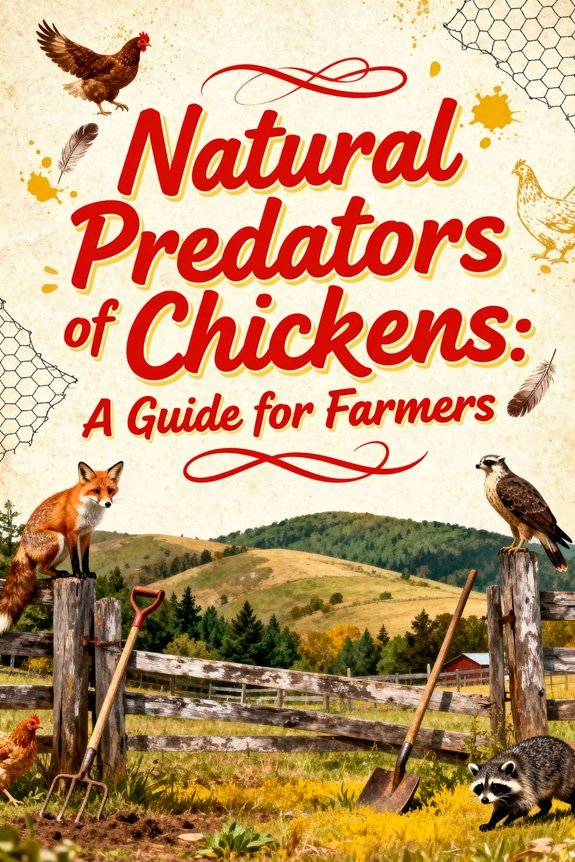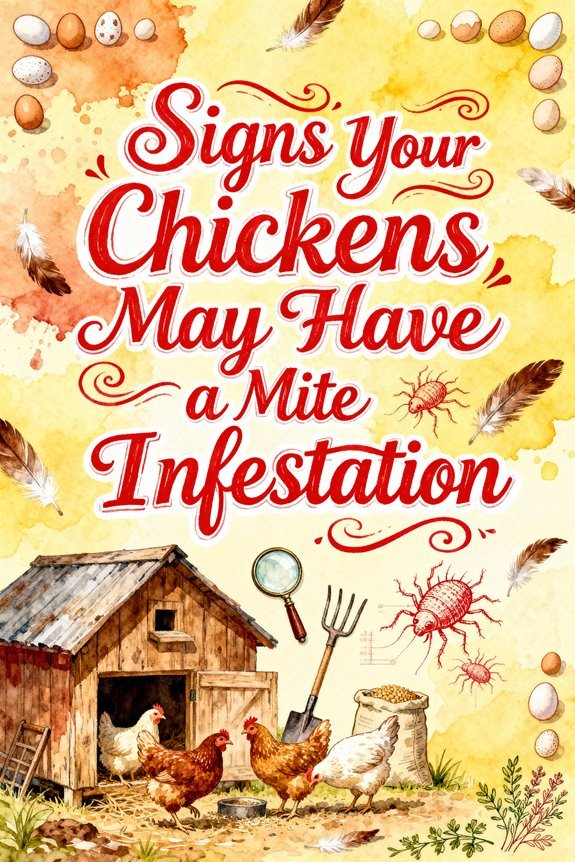Natural Predators of Chickens: A Guide for Farmers
Your chicken flock faces threats from both aerial and ground-based predators. Hawks, owls, and raccoons pose significant risks, with each species showing distinct attack patterns. You’ll need to identify predator signs like specific damage patterns, tracks, and unique kill characteristics to implement targeted defenses. Secure housing, proper fencing, and understanding seasonal patterns are essential for protection. Exploring thorough defense strategies will enhance your flock’s security against these natural threats.
Common Predatory Birds That Target Chickens
When it comes to protecting your chickens, understanding the diverse array of predatory birds is essential for effective flock management. You’ll primarily encounter three major threats: red-tailed hawks, Cooper’s hawks, and great horned owls. Red-tailed hawks, with their impressive 3.5-foot wingspan, can easily carry off full-grown chickens. Their hawk behavior includes perching visibly on dead branches to scout potential prey, while Cooper’s hawks prefer stealth attacks from within tree canopies. Owl hunting typically occurs at night, with great horned owls being particularly dangerous predators that often decapitate their prey and cache extra kills for later. While turkey vultures may alarm your flock with their 6-foot wingspan, they rarely pose a direct threat, as they prefer carrion to live prey. These predatory birds possess crushing talon power that enables them to exert up to 300 pounds of force when gripping their prey.
Ground-Based Predators and Their Hunting Patterns
While aerial predators pose significant threats from above, chickens face an equally diverse range of ground-based attackers that employ distinct hunting patterns. You’ll find raccoon hunting characterized by multiple kills per visit, typically targeting heads and crops every 4-5 nights. Opossum behavior differs, as they’ll usually take single birds and consume them onsite, leaving distinctive tracks with thumb marks. Canine attacks, from both dogs and coyotes, occur during daylight hours and often result in complete removal of adult birds. Weasel predation is particularly brutal, with multiple kills left in neat piles and minimal feeding. Snake threats primarily affect eggs and chicks, while rats target young birds and stored feed. Each predator’s unique attack pattern requires specific prevention strategies to protect your flock effectively. Domestic cats show perfect stepping patterns when stalking prey, making their tracks easily identifiable for farmers monitoring predator activity.
Understanding Predator Attack Signs
Identifying distinct predator attack signs enables chicken keepers to implement targeted defense strategies against specific threats. You’ll need to analyze both behavioral signals and environmental clues to determine which predators are targeting your flock. Look for specific damage patterns: indented panels suggest larger predators, while complex latch manipulation indicates raccoons. Track identification provides essential evidence – raccoons leave distinctive prints with longer hind feet, while opossums leave characteristic thumb marks and tail trails. Each predator exhibits unique kill patterns: raccoons target heads and crops, while opossums focus on legs and breasts. Using hardware cloth mesh on coop windows and vents provides superior protection against determined predators. Pay attention to your chickens’ behavior, as increased rooster alertness often signals aerial predators. Fresh droppings, scattered feathers, and digging patterns near the coop offer additional confirmation of specific predator species. The presence of broken egg shells in and around the nesting area often indicates raids by rats or snakes seeking to steal eggs. Installing shiny deterrents above the coop can help discourage hawks and eagles from swooping down on your flock.
Peak Predator Activity Times and Seasonal Risks
Predator activity patterns follow distinct daily and seasonal rhythms that directly impact chicken flock safety. You’ll notice most predator attacks occur during dawn and dusk when coyotes, foxes, and bobcats are actively hunting. Hawks exploit these twilight hours for ideal hunting conditions, while nocturnal predators like owls and raccoons pose threats throughout the night. These predators often leave bite marks and tracks as evidence of their attacks. Adaptable predators may remember your coop’s location and return repeatedly if successful in their initial attack.
Seasonal patterns markedly influence predator behavior. During spring and summer, you’ll face increased risks as predators forage more actively while raising their young. Winter may reduce overall mammalian activity, but food scarcity can drive desperate predators to target your confined flock. Fall migration brings additional threats from transient raptors like Cooper’s hawks. Understanding these temporal patterns helps you anticipate when your chickens are most vulnerable and adjust your protection strategies accordingly.
Essential Security Measures for Your Chicken Coop
To effectively protect your chickens from natural predators, implementing robust security measures for your coop requires a systematic, multi-layered approach. Start with solid construction using wood or metal materials, ensuring all gaps larger than 1/4 inch are sealed while maintaining proper coop ventilation through hardware cloth-covered vents. Nighttime predators like raccoons, skunks, and owls pose constant threats requiring secure nighttime enclosures. These skilled predators can be particularly destructive, with entire flocks being lost in a single attack. Motion-activated lights can startle and deter predators from approaching your coop after dark.
Your predator proofing strategy should include installing 2-step lockable latches on doors and reinforcing the perimeter with heavy-gauge hardware cloth featuring maximum 1/2-inch openings. You’ll need to bury fencing 6-12 inches underground and extend it 4-6 feet high. Install overhead protection against aerial predators and consider electric fencing in high-risk areas. Regular maintenance checks are essential – inspect for damage, patch vulnerabilities promptly, and maintain strict biosecurity protocols to minimize attractants that draw predators to your flock.
Effective Deterrent Methods and Tools
Four key categories of deterrent methods provide thorough protection against chicken predators: sensory-based deterrents, physical barriers, habitat modifications, and guardian animals. Modern deterrent technology combines motion-activated sirens, flashing lights, and inflatable decoys to create multi-layered defense systems. You’ll find sensory strategies like suspended reflective objects and recorded sounds effectively create illusion of human presence. Checking empty runs before locking up is essential to avoid trapping predators inside with your flock.
Physical protection requires strategic implementation of hardware cloth buried deep around coops, electric fencing, and predator-proof latches. You can reduce aerial predation by removing nearby perches and covering runs. Proper habitat management includes securing feed storage and conducting daily inspections. For extensive protection, consider integrating guardian animals – particularly trained dogs – which actively patrol and deter various predators while reducing your reliance on thorough fencing systems.
Regional Predator Threats Across Different Environments
Different geographic regions and habitats present unique challenges when protecting your chickens, as predator species adapt their hunting strategies to specific environments. In forested areas, you’ll encounter foxes and raccoons that excel at stealth attacks, while open farmlands attract red-tailed hawks and coyotes that utilize wide sight lines for hunting. Urban settings create unique predator-prey relationships, with raccoons and gray foxes exploiting man-made structures, while domestic pets become opportunistic threats. The increasing presence of brown and black bears in Alaska, Montana, and parts of Idaho poses additional risks, particularly during late fall and early spring.
Regional predator adaptations vary considerably in desert and wetland zones. Desert regions harbor kit foxes and various raptors that use thermal drafts, while wetland-adjacent areas support mink and weasels that specifically target poultry near water sources. Understanding these habitat-specific threats is imperative for implementing effective protection strategies.
Managing Free-Range Flocks Against Predation
While understanding regional predator threats provides a foundation for protection, managing free-range flocks requires an all-encompassing defense strategy. You’ll need to implement multiple protective measures during supervised range time, as human presence alone won’t guarantee safety from determined predators. Even with vigilant supervision, coyotes and other predators can strike swiftly and silently. Ensuring adequate natural cover and shelter through strategic placement of bushes and structures gives chickens quick escape options when threats appear. Plant snake-repelling herbs like lemongrass and marigolds around the perimeter to naturally deter reptilian predators.
To optimize flock dynamics and survival, you’ll need to focus on secure housing, strategic environmental management, and behavioral conditioning. Install reinforced fencing and hardware cloth, maintain clean surroundings, and train your chickens to return to the coop at dusk. Consider integrating livestock guardian dogs for enhanced protection, especially during nighttime hours. Remove potential attractants like spilled feed, and manage vegetation to eliminate predator hiding spots near your flock’s area. Using approved pest control methods can help prevent parasites that might weaken your flock’s health and make them more vulnerable to predators.




